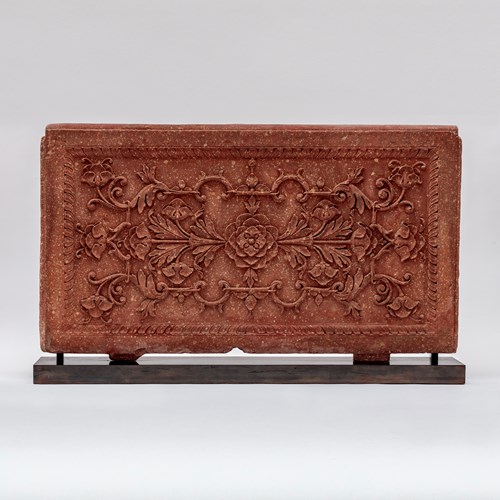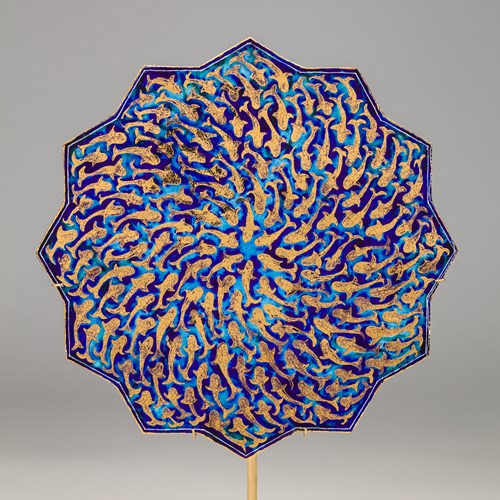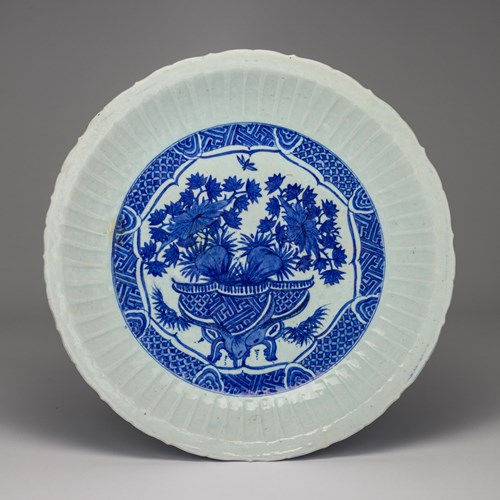Marketplace
Kara Memi Iznik Dish
A Kara Memi style dish of glazed fritware painted in red, blue, and green with the remains of gilding on the flowers. The central medallion is ornamented with sprays of carnations and tulips. The large rim is divided into nine sections by large green and blue saz leaves. Within these sections are red tulips, red hyacinths, and tiny blue prunus blossoms on the outer edge. This style of decoration, where four flowers are used, is known as the quatre fleurs motif. Each of these flowers had a specific meaning to the Ottomans: the tulip was the most sacred of the flowers as the letters in its Arabic name (لال / lale) are also used to write the name of God; the carnation was thought to be a symbol of longevity due to its extended blooming period; the hyacinth, with its curling petals, was used as a metaphor for the curly hair of a lover in 16th century Ottoman love poetry.1 The prunus, commonly the outermost floral spray on Kara Memi style dishes, symbolised Paradise.2
A dish dating to the early 17th century in the collection of the Metropolitan Museum of Art in New York (accession no. 07.143.1) is ornamented with the quatre fleurs motif, its rim similarly divided by bicoloured saz leaves. Also dating to the early 17th century is a dish of similar form in the Victoria & Albert Museum London (accession no. 950-1898), with tulips, hyacinths, carnations, and prunus blossom decoration.
1 Atasoy, Nurhan, and Raby, Julian. Iznik: The Pottery of Ottoman Turkey. London: Alexandria Press, 1989. 223.
2 ‘Interpreting Iznik floral motifs’, Illuminating Objects: Shining a light on the Decorative Arts and Sculpture Collection, https://sites.courtauld.ac.uk/illuminating-objects/illuminating-objects-home/iznik-dish/
A dish dating to the early 17th century in the collection of the Metropolitan Museum of Art in New York (accession no. 07.143.1) is ornamented with the quatre fleurs motif, its rim similarly divided by bicoloured saz leaves. Also dating to the early 17th century is a dish of similar form in the Victoria & Albert Museum London (accession no. 950-1898), with tulips, hyacinths, carnations, and prunus blossom decoration.
1 Atasoy, Nurhan, and Raby, Julian. Iznik: The Pottery of Ottoman Turkey. London: Alexandria Press, 1989. 223.
2 ‘Interpreting Iznik floral motifs’, Illuminating Objects: Shining a light on the Decorative Arts and Sculpture Collection, https://sites.courtauld.ac.uk/illuminating-objects/illuminating-objects-home/iznik-dish/
Plus d'œuvres d'art de la Galerie





 Untitled 2_T638206163538547978.jpg?width=500&height=500&mode=pad&scale=both&qlt=90&format=jpg)


_T638839371654308163.jpg?width=500&height=500&mode=pad&scale=both&qlt=90&format=jpg)
